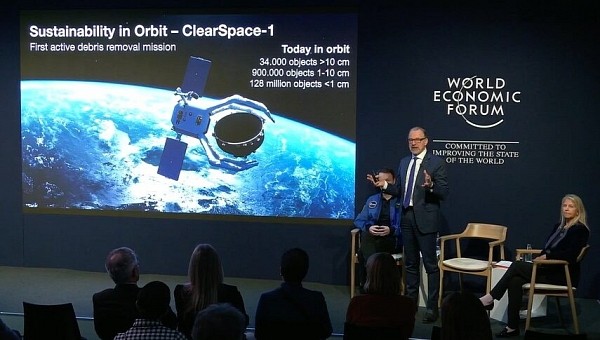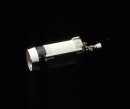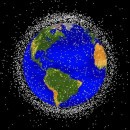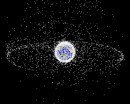Does anyone remember that scene from Futurama where the Planet Express ship blasts off into orbit, pushing a huge torrent of junked satellites out of its way? You'd be shocked at how close to reality that scene is in 2023. It's to the point NASA, the ESA, and every other space agency are on notice to do something about it.
This time, the European Space Agency (ESA) went to bat in the name of solving this problem. One that's historically rooted in science fiction and parody but is already on the verge of becoming very unfunny. It was on January 19th of this year at the World Economic Forum in Davos, Switzerland, that ESA Director General Joseph Aschbacher announced the time had come to adopt a "zero debris" policy on future missions.
"We want to establish a zero debris policy, which means if you bring a spacecraft into orbit, you have to remove it," Aschbacher declared in front of an international crowd in Switzerland. "This policy should be in place in a couple of years." Encouraging words for some, but whether or not the ESA and its partners can stick to this schedule remains to be seen
The reasons why can only be described as a proverbial hoard of space debris currently in Low Earth Orbit that ranges in size from a few millimeters across to entire satellites. As many as 36,500 satellite fragments are known to exist in LEO, depending on the data source. This becomes considerably more the smaller and smaller each fragment category becomes.
On the high side, as many as 130 million pieces of space junk barely the size of a head of a pin are floating around alongside valuable space infrastructure like the Hubble Space Telescope, the International Space Station, and dozens of others. Should even a handful of pieces of space junk impact any of these operational satellites at just the right angle, the results could be beyond devastating.
At a minimum, each piece of space debris must maintain a speed above 15,700 or so miles per hour (25,265 kph) to not plunge into the upper fringes of the Earth's atmosphere. Considering a 50. cal BMG bullet fired at sea level can blow most objects to pieces at just 2,000 mph (3,300 kph); the ballistic effects of such a ferocious impact with no atmosphere to slow things down should speak for themselves.
Global space agencies already have robust plans in place to track more substantial and intact pieces of space junk. The 2,449-kilogram (5,401 lb) Earth Radiation Budget Satellite is the most recent piece of debris to make headlines. Citing concerns about where exactly the defunct space probe would re-enter the atmosphere and impact the surface. It's hoped such initiatives like the one issued by the ESA are the first to tackle the problem at its source.
From Delta IIs to Ariane 5s and even the third stage of the Saturn V, which took Apollo 12, all have been identified at one point or another as maintaining orbits around the Earth. In the case of Apollo 12's third stage, it takes upwards of 40 years to complete a single transit between a heliocentric orbit (around the sun) and a geocentric orbit (around the Earth).
"We want to establish a zero debris policy, which means if you bring a spacecraft into orbit, you have to remove it," Aschbacher declared in front of an international crowd in Switzerland. "This policy should be in place in a couple of years." Encouraging words for some, but whether or not the ESA and its partners can stick to this schedule remains to be seen
The reasons why can only be described as a proverbial hoard of space debris currently in Low Earth Orbit that ranges in size from a few millimeters across to entire satellites. As many as 36,500 satellite fragments are known to exist in LEO, depending on the data source. This becomes considerably more the smaller and smaller each fragment category becomes.
On the high side, as many as 130 million pieces of space junk barely the size of a head of a pin are floating around alongside valuable space infrastructure like the Hubble Space Telescope, the International Space Station, and dozens of others. Should even a handful of pieces of space junk impact any of these operational satellites at just the right angle, the results could be beyond devastating.
At a minimum, each piece of space debris must maintain a speed above 15,700 or so miles per hour (25,265 kph) to not plunge into the upper fringes of the Earth's atmosphere. Considering a 50. cal BMG bullet fired at sea level can blow most objects to pieces at just 2,000 mph (3,300 kph); the ballistic effects of such a ferocious impact with no atmosphere to slow things down should speak for themselves.
Global space agencies already have robust plans in place to track more substantial and intact pieces of space junk. The 2,449-kilogram (5,401 lb) Earth Radiation Budget Satellite is the most recent piece of debris to make headlines. Citing concerns about where exactly the defunct space probe would re-enter the atmosphere and impact the surface. It's hoped such initiatives like the one issued by the ESA are the first to tackle the problem at its source.
But what exactly is this source? Well, it's a fair bit more complicated than a bunch of defunct satellites bonking into each other. All the other hardware it takes to bring said satellites into orbit are also to blame. Spent rocket stages and the debris therefrom is another vital component making space junk so dangerous for astronauts in Low Earth Orbit.
From Delta IIs to Ariane 5s and even the third stage of the Saturn V, which took Apollo 12, all have been identified at one point or another as maintaining orbits around the Earth. In the case of Apollo 12's third stage, it takes upwards of 40 years to complete a single transit between a heliocentric orbit (around the sun) and a geocentric orbit (around the Earth).
What happens when these various bits and pieces of space debris collide with each other is very similar to what happens when throwing coffee beans into a grinder. Over time, impacts between these objects whittle down larger pieces of debris into nearly microscopic pieces. It doesn't take a rocket scientist to realize why that's a potential nightmare scenario waiting to happen.





